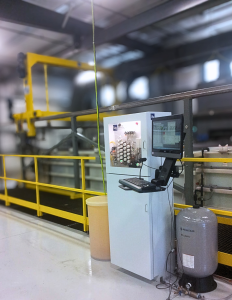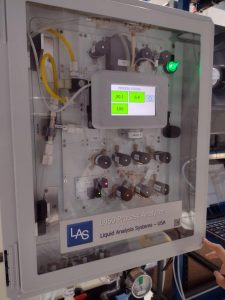Factory Floor Automated Chemical Analysis: What It Is & How It Works
Factory floor automated chemical analysis delivers real-time data and replenishment directly at the point of production, reducing quality control time from hours to minutes.
Key Takeaways
- Factory floor automated chemical analysis delivers real-time data directly at the point of production, reducing quality control time from hours to minutes.
- Implementation of automated systems can reduce manufacturing costs by up to 25% through decreased waste, optimized resource usage, and prevention of batch failures.
- Modern systems integrate seamlessly with existing manufacturing infrastructure through standardized communication protocols and Industry 4.0 connectivity.
- Automated analysis systems dramatically improve regulatory compliance by providing consistent, documented analytical results with minimal human intervention.
- Liquid Analysis Systems provides turnkey chemical analysis automation that can be operational within 4-8 weeks, transforming production efficiency for manufacturers across industries.
Real-Time Chemical Analysis Transforms Modern Manufacturing
Traditional methods required physically collecting samples, transporting them to laboratories, performing manual analysis, and finally communicating results back to production teams – often hours or days after the sample was taken. By then, production problems had already created waste, compromised quality, or even resulted in complete batch failures.
Liquid Analysis System’s automated on-line spectroscopy and titration systems perform continuous analysis directly upon production processes. Real-time analytical results enable rapid adjustments to process conditions, maintaining optimal production parameters that prevent quality impacts before they occur.
The impact on manufacturing performance is profound. Plants utilizing automated chemical analysis typically report 15-30% reductions in process variability, 10-25% decreases in material waste, and significant improvements in first-pass quality rates.
Key Functions of On-Line Chemical Analysis Systems
Complete on-line analysis systems comprise four key functions:
-
- Sampling,
- Analysis,
- Data Processing, and
- Systems Integration
Sampling Approaches: How Automated Systems Collect Samples
The first challenge in automated analysis is obtaining representative samples from production processes. The primary approaches are in-line, on-line, and at-line methods. In-line analysis places sensors directly in the process stream, providing continuous measurement without sample extraction. On-line systems automatically extract samples from processes, perform analysis, and either return the sample to the process or discard it. At-line systems use human assistance to transfer samples to nearby analyzers designed for factory environments.
While in-line systems provide continuous readout with minimal lag time, they are susceptible to fouling and drift. The process engineer must evaluate these tradeoffs. At-line systems offer more sophisticated analyses, but if partially automated, these may not accomplish the response time and degree of autonomy required. In addition to sampling, on-line systems offer the benefits of stream multiplexing, auto-calibration, execution of a breadth of analytical methods, and periodic self-cleaning.
For liquid samples, on-line system sampling is achieved either by a slip stream or an educted sample.
- With a slip stream, the sample’s motive force is outside the analyzer, such as from a filter pump. In this case, sample flows continuously to (or through) the analyzer.
- With an educted sample, the motive force is inside the analyzer: the sample is drawn in by vacuum.
The former is quickest; the latter can be more economical. In either case, the selected stream is diverted via sample valves, after which it is either directed to flow past a sensor or measurement window, such as for pH or spectroscopy, or is captured volumetrically. Sample capture is used in the case of a wet chemical analyzer, such as for titration or colorimetry, where a volumetric aliquot is dispensed into a measuring vessel for further preparation and/or analysis.
Analytical Instruments: The Eyes of the Operation
The analytical instrument does the work of detection. Its output must be specific to the species of interest, reliable, consistent, and accurate. Specific means not only is a parameter of interest reported but its result is not influenced by other components.
This largely depends on the analysis method: it can be easy to detect an analyte but much more difficult to exclude all others. For example, it is easy to detect peroxide among organic constituents but difficult to prevent oxidation (and misleading inclusion) of those organics.
Reliability is desirable with any instrument but with an on-line one, it is mandatory. The whole nature of the project and the downstream consequences depend on this.
Consequently, design margins must be ample and cross checks and self-tests built in. Consistency matters simply because without it, the process and its product cannot in turn be so. Accuracy ensures that established standards are met. It also guarantees that outcomes at different sites or from different machines match.
For wet chemical process measurements, titration is ubiquitous. Titration, unlike most any other method, is a direct rather than relative measurement: It need not rely on calibration. (It does rely on standardized reagents.) But the reason for its widespread use is also its ability to stress test a sample, arriving at its result by depletion of the analyte, indicating performance under actual use. The sensor selected for this titration depends on the analyte; color, pH, ORP, ISE, surface tension, and even temperature are examples. In these cases, dependence on calibration is further reduced or even eliminated – and immunity to drift is gained – by employing a differential end point. This is where, on a plot of signal strength versus titrant volume, a maxima reveals the titer at which the analyte is consumed. The concentration is then calculated from the volume and concentration of the titrant used.
Another popular method is colorimetry. It is simpler and can be faster than titration. And although its range can be limited due to non-linearities, its low-end sensitivity can be excellent. In principle, colorimetry uses an indicator reagent which combines with the species of interest to form a colored complex with intensity proportional to concentration.
Spectroscopy, where a spectrum is used rather than a single color or wavelength, can be a powerful on-line analytical tool. More recently Raman spectroscopy has been put to use on the factory floor. Unlike colorimetry, it does not suffer from high-range non-linearity, nor does it usually require reagents for concentration above, say, 250 ppm. Measurement times are on the order of seconds to minutes, depending on the concentration range. Drift can occur, but this is minimized with auto-baseline software and adequate process characterization to know beforehand where other constituent signals are so as to either avoid them or measure and compensate for them. Principle Component Analysis (PCA) simplifies the latter task if adequate training standards are available, using the entire spectrum to deconvolute (distinguish) spectral data from each component.
Integration with Manufacturing Execution Systems
From process measurements, historical data provides valuable insights for process optimization, troubleshooting, and continuous improvement initiatives. Most systems maintain complete audit trails for regulatory compliance, automatically documenting all analytical results, calibrations, maintenance activities, and operator interactions.
The true power of automated chemical analysis emerges when these systems are fully integrated with broader manufacturing control infrastructure. Modern implementations typically connect directly to replenishment systems, Distributed Control Systems (DCS), or Supervisory Control and Data Acquisition (SCADA) platforms through standardized protocols or industry-specific standards. This integration enables automated process adjustments based on analytical results without human intervention.
The Continuous Monitoring Process
Modern automated systems operate in a continuous cycle that begins with scheduling. Advanced systems intelligently determine when analysis should occur based on production schedules, process conditions, or time intervals. This adaptive scheduling optimizes analytical resources while ensuring sufficient monitoring frequency. Once initiated, the sampling mechanism extracts representative material from the production process with minimal disruption to ongoing operations.
Quality Control Improvements
The most immediate impact of automated analysis typically appears in product quality metrics. By providing continuous visibility into chemical properties throughout production, these systems prevent quality deviations rather than simply detecting them after they occur. This paradigm shifts from reactive to preventive quality control significantly reduces defect rates and quality-related losses. Defect reductions from implementing analytical automation can be substantial but must be evaluated on a case by case basis. These systems can also be certified to meet Nadcap requirements for aerospace manufacturing.
Waste Reduction and Resource Optimization
Substantial economic benefits emerge from improved resource utilization enabled by continuous analytical feedback. Real-time composition data allows precise adjustment of raw material inputs, minimizing excess additions that waste valuable resources. Energy consumption often decreases significantly as processes operate consistently at optimal conditions rather than utilizing excess energy as a safety margin against quality variations. Process yields can also improve after implementing automated analysis systems and a seemingly modest gain can translate to substantial financial impact in high-volume operations.
Production capacity often increases without capital expansion as manufacturers reduce or eliminate hold times previously required for laboratory testing. This hidden capacity gain can represent a 10-15% production increase without additional equipment investment. Similarly, inventory carrying costs decrease as manufacturers gain confidence in consistent quality, reducing safety stock requirements and working capital commitments.
Batch rejection and rework costs typically decrease dramatically, often by 30% or more, as analytical systems prevent off-specification production rather than simply identifying it. The combined impact of these resource optimizations frequently exceeds the direct quality improvement benefits, particularly in resource-intensive industries like chemical manufacturing, food processing, and electronics production.
Frequently Asked Questions
How much does a factory floor chemical analysis system typically cost?
Implementation costs vary dramatically based on analytical requirements, production environment, and integration complexity. Basic systems start around $20,000-$100,000 for single-parameter monitoring with simplified integration. Comprehensive multi-parameter systems with full production integration typically range from $150,000 to $500,000 per production line.
Can automated chemical analysis systems replace laboratory testing completely?
While automated systems dramatically reduce laboratory testing requirements, complete elimination is rarely practical or advisable. Most successful implementations establish complementary roles, with automated systems handling routine monitoring while laboratories focus on method development, system verification, complex problem-solving, and specialized analyses. This approach leverages the strengths of each methodology—automated systems providing continuous, real-time data directly from production processes, and laboratory methods offering deeper analytical capabilities for complex situations. The optimal balance varies by industry, with regulated industries like aerospace typically maintaining more extensive laboratory capabilities while process industries like petrochemicals might automate 90%+ of routine testing.
What maintenance is required for these systems?
Modern automated analysis systems incorporate numerous features that minimize maintenance requirements, including self-cleaning mechanisms, automatic calibration routines, and predictive diagnostic capabilities. Typical maintenance activities include scheduled replacement of consumables (lamps, filters, seals), periodic recalibration with certified reference materials, and preventive maintenance of mechanical components like pumps and valves. Well-designed systems typically require 2-4 hours of maintenance per month, depending on analytical complexity and operating environment. Many manufacturers adopt performance-based maintenance contracts that guarantee system availability while optimizing maintenance activities based on actual system condition rather than fixed schedules.
How long does it take to implement an automated chemical analysis system?
Implementation timelines depend on system complexity, integration requirements, and validation needs. Basic on-line systems can be operational within 4-8 weeks, while comprehensive systems with full production integration typically require 3-12 months from initial specification to validated operation. Regulated industries like aerospace may require additional time for method validation and regulatory documentation. Phased implementation approaches allow manufacturers to realize benefits quickly while building comprehensive solutions, with each phase typically delivering positive returns that help fund subsequent expansions.




